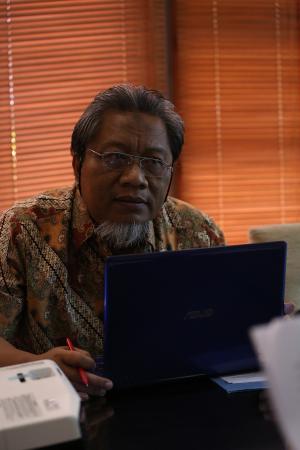One of the Professor Chair Holders of IPB: Anther Culture Technique to Expedite Rice Breeding Program

One of the Professor Chair Holders of the Faculty of Agriculture, Bogor Agricultural University (IPB), Prof. Sapta Bambang Purwoko, said that the plant breeding process takes around seven to eight years to get superior varieties. However to increase food insecurity, agriculture in developing countries must undergo a significant transformation in order to increase production and respond to climate change. Thus, increasing rice productivity through high-yielding varieties is really required. The statement was stated in his press conference pre his scientific oration at IPB Campus Baranangsiang Bogor, on Thursday, 4 August 2016.
He said Anther culture technique is important because it is a way of producing haploids (plants with an n chromosome number). Production of haploids shorten the time for inbreeding for superior hybrid genotypes. Anther culture provides a quick route in obtaining pure lines in a single generation from either green haploid plant that are artificially or spontaneously doubled. Thus, anther culture technique offers great opportunities for accelerating breeding progress and improves grain quality characters. With this technique the breeding program will be shorter and speed up the selection process.
The conventional breeding techniques are time consuming and self incompatibility act as barrier for distant hybridization and fertilization. Production of double haploids through anther culture is a rapid approach to homozygosity that shortens the time required for the development of new rice cultivars as compared to conventional methods, which require at least 6-7 generations. By anther culture crosses process has been shortened to just one season. So it is about 3-4 years shorter than conventional techniques.
"Anther culture is the process of using anthers to culture haploid plantlets, it is utilized to produce spontaneous double haploids from randomly selected heterozygous. The application of anther culture techniques require fewer personnel and less lands. Therefore, anther culture proved to be an ef?cient method in plant breeding programmes with lower costs than alternative technologies., "he said.
But the question was, why anther culture techniques have not been developed in Indonesia? The problem turned out to be rice breeding in Indonesia has generally been based on the result of crosses beeding between indica rice subspecies. Indica rice are known as recalcitrant genotypes because it is difficult to obtain sufficient number of green plantlets of the regenerated plants from anther cultures. The results indicated that the callus growth and plant regeneration in the anther culture were varied within the indica rice genotypes. Low anther culture response, high percent of albino plantlet regeneration and abundance of haploids are the principal constraints in establishing successful anther culture in rice. Indica rice are known as recalcitrant genotypes because it is difficult to obtain sufficientnumber of green plantlets of the regenerated plants from anther cultures. Indica rice are known as recalcitrant genotypes because it is difficult to obtain sufficient number of green plantlets of the regenerated plants from anther cultures.
Callus inductions were done in a basal medium of N6 +10-3 M putrescine, while plant regenerations were conducted on abasal medium of MS + 10-3 M putrescine. The results indicated that the callus growth and plant regeneration in the anther culture were varied within the indica rice genotypes. The anther culture technique was successfully used to regenerate green plants of five indica rice genotypes tolerant to Al toxicity. Abilities of indica rice genotypes to produce green plants varied.
Anther culture provides a quick route in obtaining pure lines in a single generation from either green haploid plant that are artificially or spontaneously doubled. Researches discovered that within 2-3 years another superior rice strains has successfully bred. Including disease resistant rice varieties, and Abiotic Stress which including drought, salinity, and low temperatures.
"INPARI HBD rice variety released in 2013 (proposed by BB Biogen) was the result of anther culture. Institut Pertanian Bogor (IPB – Bogor Agricultural University) and its partners, Biogen BB and BB Rice, will release another doubled haploid (DH) of tolerant upland rice strain, "he said.
To acknowledge this innovation, Prof. Bambang, was awarded 102 Most Prospective Indonesian Innovation by the Ministry of Research and Technology in 2010 for his innovative work "Development of New Rice Strain through Anther Culture Technique for National Food Security".
"This technique is a promising future. Namely selection will operate to reduce mutation rates, the acceleration of transgenic rice varieties and the genetic analysis, particularly for quantitative traits. Thus, the genetic improvement of the crop in order to create desired plant types that are better suited for cultivation, give better yields and are disease resistant could be produced" he said. (Wied)



